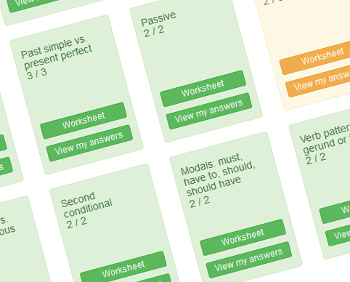Diateza pasivă
(Passive)
Introducere
Diateza pasivă este folosită cel mai adesea pentru:- documente scrise oficiale sau academice; eseuri, rapoarte, articole
- știri: titluri, reportaje.
- The fire was started (Focul a fost aprins) de către Robin.
- My car was stolen last night.
Cum se formează
Diateza pasivă se formează astfel:"be" + participiul trecut al verbului principal.
Prezentul simplu la diateza pasivă - exemple:
| complement | Verbul "be" | Verbul principal | Complement | Subiect |
|---|---|---|---|---|
| The experiment |
is
isn't is not |
carried out | every week | by scientists at the university. |
| The experiments |
are
aren't are not |
carried out | every week. |
| Verbul "be" | complement | Verbul principal | Complement | Subiect |
|---|---|---|---|---|
| Are | the experiments | carried out | every week? |
Trecutul simplu la diateza pasivă - exemple:
| complement | Verbul "be" | Verbul principal | Complement | Subiect |
|---|---|---|---|---|
| The experiment |
was
wasn't was not |
carried out | every week | by scientists at the university. |
| The experiments |
were
weren't were not |
carried out | every week. |
| Verbul "be" | complement | Verbul principal | Complement | Subiect |
|---|---|---|---|---|
| Were | the experiments | carried out | every week? |
Diateza pasivă poate fi utilizată cu orice timp verbal:
|
Obiect (face obiectul acțiunii) |
Verbul "be" (dferite timpuri) |
Verbul principal (participiul trecut) |
|---|---|---|
| The dogs | are | fed. |
| are being | ||
| were | ||
| were being | ||
| are going to be | ||
| will be | ||
| have been | ||
| will be being | ||
| have been being | ||
| had been |
În exemplul de mai sus nu știm cine hrănește câinii. Nu este important. Este important că aceștia primesc hrană.
Dacă vrem să includem persoana care realizează acțiunea, putem folosi prepoziția "by":
- The dogs are being fed by a charity worker.
Exerciții
Completați propozițiile cu forma corectă a verbelor dintre paranteze la trecutul simplu, diateza pasivă:
.Further practice
.Aspecte lingvistice suplimentare
Putem folosi diateza pasivă atunci când nu dorim să precizăm cine a realizat acțiunea:- "I’m sorry but your vase was broken."
- "My homework was lost."
- "The accounts have been messed up."
Verbele modale pot fi folosite la diateza pasivă:
Present
Activă – The staff should make the beds every day.
Pasivă – The beds should be made every day.
Past
Activă – The staff should have made the beds every day.
Pasivă – The beds should have been made every day.
Aspect lingvistic de nivel avansat
Exemple suplimentare pentru diateza pasivă:- viitorul perfect –
The dogs will have been fed. - viitorul perfect continuu –
The dogs will have been being fed. - mai mult ca perfectul continuu –
The dogs had been being fed.
Chiar dacă folosirea lor este corectă din punct de vedere gramatical, aceste timpuri perfecte continue nu sunt utilizate în mod obișnuit la diateza pasivă. Situațiile descrise nu au loc de obicei și exprimarea ar fi destul de neobișnuită.
Create a free Getting Started account
Link-uri conexe
Următoarele exerciții includ utilizarea acestei structuri gramaticale:
V-ar putea interesa și:
V-ar putea interesa și:
Beginner
- Trecutul simplu
- Trecutul continuu
- Prezentul simplu
- Prezentul continuu (prezent)
- Prezentul perfect
- 'Going to' și 'will'
- Prezentul continuu (viitor)
- Imperativul
- To be (a fi)
- Pronume: subiect, obiect
- Pronume: relative
- Adjective și pronume posesive
- Adjective și pronume demonstrative
- Ordinea adjectivelor
- Întrebări cu WH (pronume interogative)
- Articole: a, an, the
- Prepoziții: timp și spațiu
- There is/ there are și cuantificatori
- Conjuncțiile and, or, but
- Comparative / superlative (than)
- Fraza condițională de tip 0 (if)
- Fraza condițională de tip 1 (if)
- Verbe modale: can/can't, could, will, shall
- Structuri verbale
- Sequence adverbs
Nivel intermediar
- Mai mult ca perfectul
- Trectul simplu vs. Prezentul perfect
- Trecutul simplu vs. Trecutul continuu
- Prezentul perfect continuu
- Viitorul simplu
- Viitorul continuu
- Passive
- Vorbirea indirectă
- Used to/would
- Fraza condițională de tip 2
- Fraza condițională de tip 3
- Propoziții relative
- Pronume reflexive
- Verbe modale: must, have to, should, should have
- Structuri verbale: gerunziu sau infinitiv
- Adverbe de grad
- Ordinea adjectivelor
- Adjective: ed sau ing
Grammar
Identificați rapid și concentrați-vă asupra problemelor de gramatică:
- Foi de lucru și teste gramaticale
- Scenario-based grammar exercises
- Grammar additional practice questions
- Exerciții cu conjugarea verbelor
- Exerciții cu condiționalul
Îmbunătățiți-vă gramatica
Vocabular
Vocabulary exercises:Extindeți-vă vocabularul folosind cei trei antrenori de vocabular:Exersați-vă ortografia folosind cele trei teste de ortografie:Exersați vocabularul referitor la grafice și diagrame:
Lecții de vocabular
Exerciții de dictare
Exersați-vă abilitățile de ascultare și ortografia folosind exercițiile noastre de dictare:
- Scenario-based dictation exercises - general English
- Scenario-based dictation exercises - business English
- Dictare: accentul pe gramatică
- Numere
Realizați exerciții de dictare
Lecții video
Concentrați-vă pe anumite zone din engleza pentru afaceri folosind lecțiile noastre video:
Participați la o lecție video





